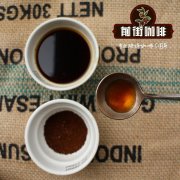Introduction to G1 Flavor of slow dry treatment in Ethiopian Water washing Yega Xuefei Hofsa Village

Professional coffee knowledge exchange More coffee bean information Please pay attention to coffee workshop (Weixin Official Accounts cafe_style)
Yegashefi is one of Ethiopia's finest producing areas. The climate and geographical conditions here are especially suitable for the growth of coffee. It is located in the plateau of 700~2100 meters and it is like spring all the year round (is it very similar to Yunnan, China). Therefore, the coffee planted is rich in flowers and fruits, and at the same time has the smell of citrus and lemon. It is mellow and charming, with endless aftertaste.
This plant, located about eight kilometers west of the town centre of Yeka Coffee, has excellent conditions-it is located in an environment with an altitude of 1900 to 2200 meters on the surrounding slope. The berries delivered by nearby farmers at high altitudes have typical Hafursa/Haru basic tones: washed with water, they have obvious lemon tones, bright and high, and fine texture...
Usually Ethiopia's washing plants use well-ventilated "African Bed" insolation during the drying phase, especially if single/thin layers of shelled beans are used (the sun rule is berries). The high sun and very good ventilation conditions common in harvest season often make the drying rate very fast. Even with average thickness African bed exposure, washed beans usually only need to be washed in continuous sunlight.
Drying can be completed in 10 to 12 days (sun beans are usually about two weeks).
This time, the "half-shade slow drying" method focuses on reducing the heat of sunlight, using seemingly primitive shade nets to block sunlight; of course, the shade rate of these shade nets (25%~ 70%, rather than true "half" shade) varies, and their effects vary more or less…
The key principle is: since the air is already quite dry, we really do not need to let 100% direct sunlight to dry the bed, let the shelled beans be overheated and dried by the sun…After the shade ratio is actually measured and set by Lux Meter, the drying period of 10~12 days can be accurately set to 16~18 days or even 26~30 days.
Flavor: Lemon, jasmine aroma, fruit juice taste, sour and sweet taste, such as fruit sugar taste, acid lively rise, sweet and lasting finish
Important Notice :
前街咖啡 FrontStreet Coffee has moved to new addredd:
FrontStreet Coffee Address: 315,Donghua East Road,GuangZhou
Tel:020 38364473
- Prev

What is the Red Cherry Project? Yega Snow, Red Cherry, Red Cherry Plan, Coffee Bean treatment
Professional coffee knowledge exchange more coffee bean information please follow the coffee workshop (Wechat official account cafe_style) Trabocca B.V. It's a Dutch coffee bean trading company. The company has a deep relationship with Ethiopia, and its founder, Menno Simons, knew little about coffee until he was accidentally caught on a trip to Ethiopia.
- Next

What is true Blue Mountain Coffee lims Blue Mountain Coffee is it true? how about Malaysia Blue Mountain Coffee?
Professional coffee knowledge exchange more coffee bean information please pay attention to the coffee workshop (Wechat official account cafe_style) there are a lot of blue mountain flavor coffee, blue mountain instant coffee, these are not the real blue mountain coffee, businesses play word games, is made of different beans, similar to the flavor of blue mountain coffee, after all, the real blue mountain coffee price is right and wrong
Related
- Detailed explanation of Jadeite planting Land in Panamanian Jadeite Manor introduction to the grading system of Jadeite competitive bidding, Red bid, Green bid and Rose Summer
- Story of Coffee planting in Brenka region of Costa Rica Stonehenge Manor anaerobic heavy honey treatment of flavor mouth
- What's on the barrel of Blue Mountain Coffee beans?
- Can American coffee also pull flowers? How to use hot American style to pull out a good-looking pattern?
- Can you make a cold extract with coffee beans? What is the right proportion for cold-extracted coffee formula?
- Indonesian PWN Gold Mandrine Coffee Origin Features Flavor How to Chong? Mandolin coffee is American.
- A brief introduction to the flavor characteristics of Brazilian yellow bourbon coffee beans
- What is the effect of different water quality on the flavor of cold-extracted coffee? What kind of water is best for brewing coffee?
- Why do you think of Rose Summer whenever you mention Panamanian coffee?
- Introduction to the characteristics of authentic blue mountain coffee bean producing areas? What is the CIB Coffee Authority in Jamaica?

